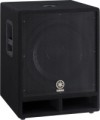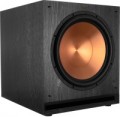Type
— Active. Subwoofer with its own built-in amplifier. This allows you to connect the device to the signal source directly, without any additional external amplifiers. If the connection is made through a common speaker amplifier, the
active subwoofer reduces the load on it, which has a positive effect on the volume and sound quality of the entire speaker. The built-in subwoofer amplifier itself is selected in such a way as to optimally match the characteristics of the speakers used. In addition, active subwoofers often come with their own fine-tuning tools that allow you to achieve optimal sound in your room without moving the subwoofer itself. The disadvantages of an active subwoofer are the need for a separate power connection and the high price.
— Passive. Subwoofer without its own built-in amplifier. Such a device requires connection to the signal source through an external amplifier, the characteristics of which should optimally match the characteristics of the subwoofer (see Power, Impedance). The advantage of
passive subwoofers is their low cost.
Features
—
Home. General purpose subwoofers not covered by any other specialty (see below). The name “home” quite accurately describes their main purpose, but, of course, the matter is not limited to home acoustic systems: such “subs” can be used in cafes and bars, on skating rinks and rollerdromes and other public places.
—
Concert. Subwoofers designed for use at concerts and other mass events are distinguished primarily by high power — hundreds or even thousands of watts. This allows you to cover large areas with powerful rich sound.
—
Studio. Subwoofers designed for professional audio applications, primarily in recording studios. They are also called "monitors" (however, this is the common name for all studio speakers). Differ in extremely high fidelity of a sound transmission.
—
Landscape. Models designed for outdoor installation — for example, in the courtyard of a private house, on the territory of an entertainment complex, etc. The most noticeable difference between such models and classic home ones is their appearance: landscape subwoofers must fit into the design of the area, so they are often “disguised” as a stone, flower pot, ground lamp, etc. In addition, the cases of such speakers are well protected from moisture, dust and other adverse factors associated with being outdoors. And the placement method m
...ay involve not only simple installation on the ground, but also digging into the ground, depending on the model.
Note that the use of a subwoofer for other than its “native” purpose is technically possible, however, usually, it is not justified: a concert model in the house will be redundant, an ordinary home “sub” can be put outside only until the first rain, etc.Power
Rated power of the subwoofer. Technically, this is the highest average (rms) sound power at which the device can work normally (without sound distortion and damage to components) for an unlimited time. Simply put, the more powerful the subwoofer, the louder it is. The choice for this parameter depends primarily on the size of the space / room that is planned to be covered; detailed recommendations for different situations can be found in special sources.
Also, the power is directly related to the characteristics of the amplifier used with the subwoofer. For active subwoofers (see "Type"), this item actually indicates the nominal power of the built-in amplifier; the speaker itself can be more powerful, but it doesn't matter anymore. For passive models, the power rating corresponds to the highest amplifier power that can be connected to the speaker without the risk of damaging it at high volume.
Sensitivity
The sensitivity value determines the volume of the subwoofer when an external signal of a certain power is connected to it. The higher the sensitivity, the louder the sound will be, with equal signal power and impedance.
Max. sound pressure level
The highest sound pressure level that a subwoofer can create, in other words, the volume that it produces at its maximum power level. This parameter is measured in the same way as any noise level - in decibels; since the decibel is a non-linear quantity, it is easiest to evaluate loudness using comparative tables. So, the most modest modern subwoofers are capable of delivering up to 95 – 100 dB, this is comparable to the volume of a subway car or a chainsaw. In the most powerful ones, it can exceed 130 dB - this is louder than an airplane on takeoff, a long stay near a subwoofer operating at full power can lead to hearing damage.
Note that sound pressure and sensitivity (see above) are fundamentally different characteristics, although they are measured by the same units.
Impedance
Subwoofer AC impedance. This parameter matters primarily when connected to an external amplifier: if the impedance is lower than that of the amplifier, sound distortion is possible, if the impedance is higher, the subwoofer may sound quieter than we would like.
Frequency range
The range of audio frequencies reproduced by the subwoofer. As a general rule, the wider the frequency range, the richer the sound and the more detail the speaker can convey. However, it is worth remembering that subwoofers as a class are designed for low and ultra-low frequencies in the range from 20 to 150 (sometimes 200) Hz. Therefore, in fact, a significant difference in sound is noticeable only with a large difference in the reproducible ranges (for example, 20-200 Hz and 50-150 Hz).
Also, do not forget that an extensive frequency range is not yet a guarantee of high-quality sound; and in some cases (for example, if the main speakers of the speaker also cope well with low frequencies), it may be completely redundant.
Phase adjustment
The ability to shift the sound produced by the subwoofer in phase — usually by 180 °, but in some models the option is also available by 90 °.
Sound vibrations can be represented as a sinusoid. In some cases, the sinusoids from the subwoofer and from the main speakers may be out of phase — for example, with a difference in distance, inconsistency in the operation of amplifiers, etc. This degrades the sound quality. And
the phase adjustment allows you to correct the situation and coordinate the subwoofer with the rest of the components of the speaker system.
Level adjustment
The subwoofer has its own
level control, in other words, a volume control. Adjusting the bass with such a control is often easier than digging into the settings of an amplifier or other external device.

